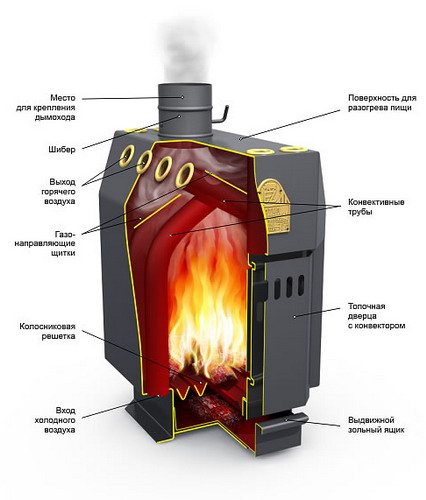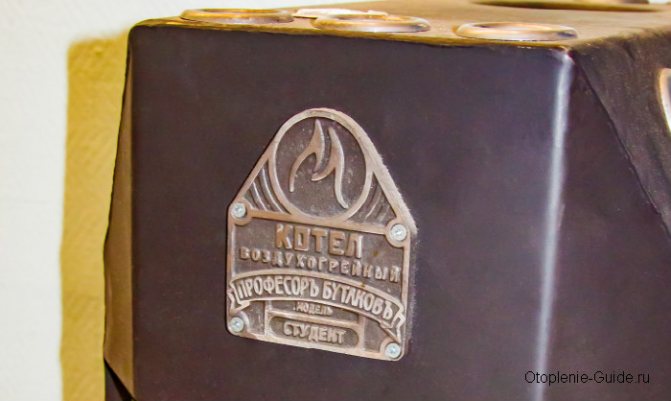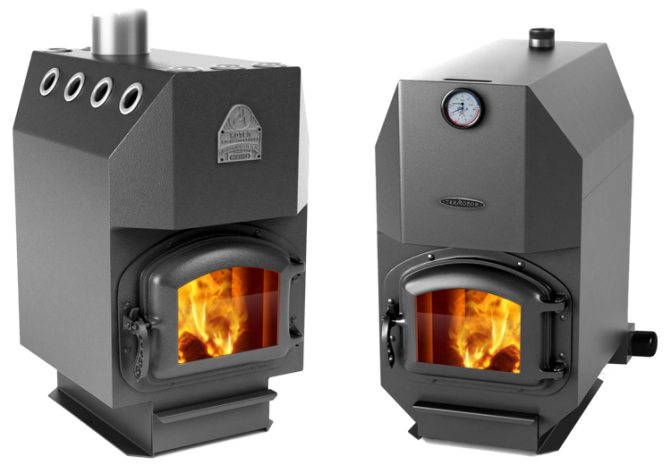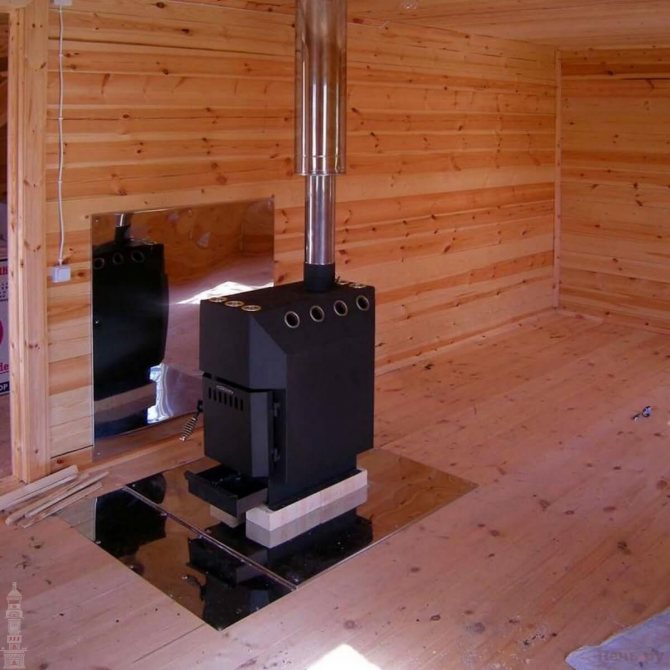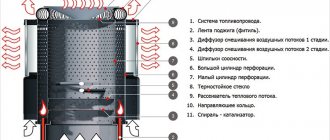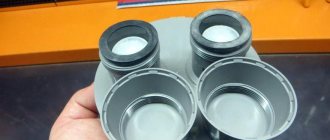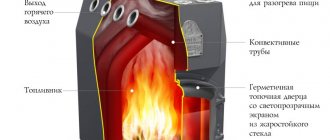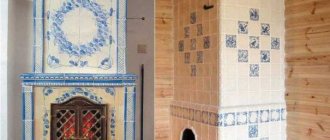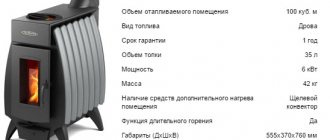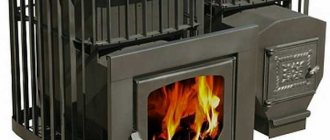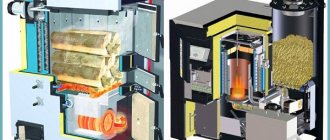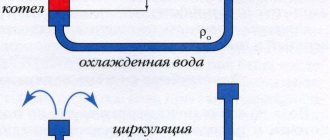We must pay tribute to Professor Butakov - the inventor of gas-generating furnaces, which have gained popularity among the Russian population. They are widely used in everyday life due to their high heating capacity, power, efficiency and functionality. To heat a relatively large room, fuel will be required 2 times less than, for example, when using a stove with brickwork, and also 12 times less than a stove. The design of this stove is not much different from an iron temporary stove, so the unit has found its application in heating summer cottages, garages, large storage rooms, hangars, change houses, mobile booths.
Furnace design
Butakov's heating device is very simple. The unit consists of the following elements:
- ash pan for collecting decomposition products during combustion;
- air outlet pipe;
- two-chamber firebox: one compartment is provided for connecting to gas, the second is for afterburning fuel;
- a grate in the form of a shutter;
- smoke channel.

The pipes run along the edge of both sides of the oven, are arranged in two rows, close and cross at the top of the oven. Thanks to this design, the floor heats up well when cold air moves through the pipes located in the combustion zone. Due to them, the heating area increases and the furnace walls do not burn out. Thanks to special jets with hot air inside, located at the top of the furnace, the secondary gas is burned in full. This once again confirms the efficiency of the device: the fuel burns out entirely, and the heat is retained for a long time inside the room.
A bit of history
Photo of Butakov's stove
Many engineers have worked to improve the efficiency of the furnaces and increase their functionality.
The Soviet engineer S.E. Butakov. He created his author's furnace at the Ural Institute back in the 60s of the last century. The principle of its development was similar to that of similar furnaces.
But the main features of the Butakov furnace are an increase in the efficiency of equipment operation and a decrease in heat losses. By making changes to the design of his creation, Butakov managed to raise the efficiency of a traditional furnace to an incredible level at that time - 85%. This allows them to compete with gas heating equipment.
Principle of operation
Functioning the oven is carried out at the same time by pyrolysis and convection:
- Pyrolysis process takes place directly in the firebox. In this case, the fuel does not burn, but simply smolders. By closing or opening the door vent, you can regulate the supply of fresh air inside. During this process, a large amount of gas is released, directed to the second chamber, where, when mixed with oxygen, it is burned in full. At the same time, the air in the room is always fresh.
- Convection process occurs in special pipes installed in the structure. Through ducts mounted in the firebox with protruding ends at the outlet, hot air is directed directly into the room. In this case, heating is carried out in a natural way. The intake of cold air is carried out in the lower openings of the pipes. It passes through the entire structure and is directed upward when hot. However, this leads to sharp temperature changes in the chimney, therefore condensation may form, which is a significant disadvantage of such a design. But the problem can be solved if you install a branch pipe.Through it, the condensate will not be released outside, but will settle directly in the firebox, in which it will simply evaporate under the influence of heat.

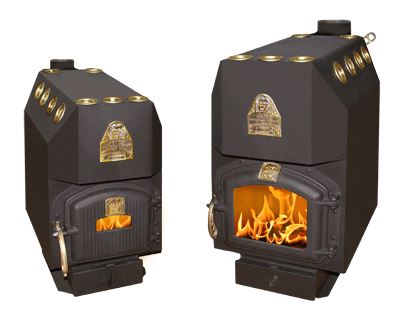
Potbelly stoves and many pyrolysis units work in approximately the same way, but there are still some differences. Among them, the following are noted:
- The pipes in the furnace are not installed randomly, but at an angle. It is important to set the exact angle when setting up the structure yourself.
- The doors are not just hinged, they contain a convection chamber, which contributes to faster and more uniform heating of the room.
- The oven, unlike some pyrolysis models, is quite easy to maintain. The ash pan can be easily removed and cleaned quickly. Among such structures, it is the Butakov's unit that is considered the most efficient, simple, with high heat output.
General information
The range of heaters is represented by five types:
- Student.
- Professor Butakov-Engineer.
- Assistant professor.
- High school student.
- Professor.
According to numerous reviews of the inhabitants, the "Professor" heating boiler is the most profitable in its category.
The stove "Professor" of unsurpassed design is intended for heating air in rooms of large volumes: for summer cottages, production, storage facilities.
The Butakov's stove is a long burning device. You can find out more about similar wood-burning stoves here:
Advantages and disadvantages
Among the advantages, the following points can be noted:
- Due to its volume, the elongated ash drawer does not require frequent cleaning.
- Convection pipes are located at a certain distance from the floor.
- Acceptable price. The device is notable for its low cost, since it has a simple design and was invented long ago without the use of expensive materials.
- The device is not oversized, but roomy.
- The oven surface can be used for cooking or heating water.
- The construction is robust, which is also facilitated by the material used. The system has a long service life, does not need frequent and careful maintenance. The main thing is to remove ash on time. For this purpose, a special container is installed in Butakov's oven. You do not have to wait for the fuel to burn out, but remove the ash directly during operation.
- The unit is capable of heating a room with an area of up to 1500 sq. meters.
- The stove runs on any fuel: coal, wood, peat, pellets, cardboard remnants, pressed paper, etc.
- The device is environmentally friendly and fireproof.
- It has an attractive appearance.
- Installation is quick, no special skills are required.

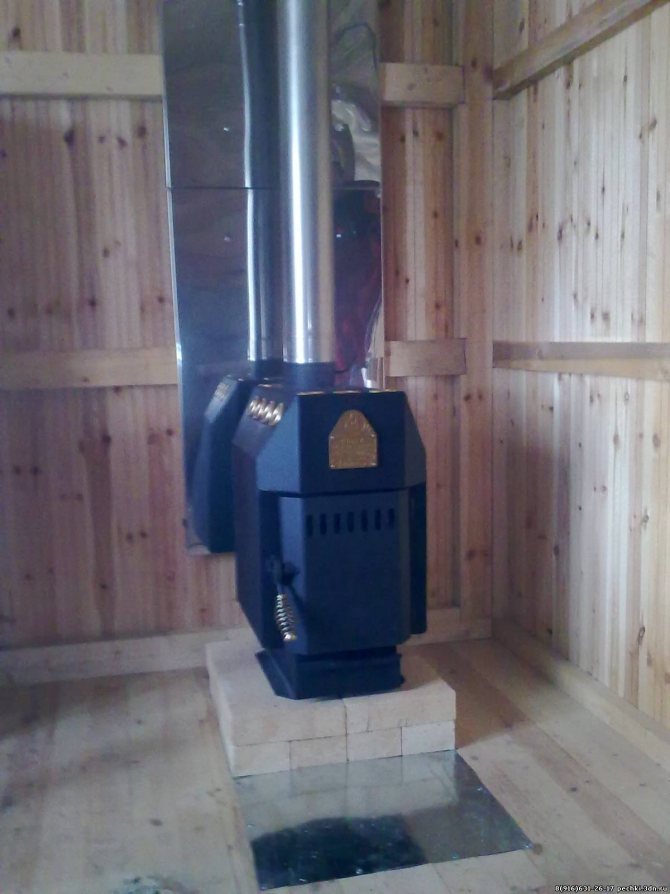
Basic information about the furnace in question
Furnaces "Professor Butakov" are both very productive and visually attractive equipment.
Design
The design is equipped with oversized convection pipes. Directly, the pipes are arranged according to a more efficient and patented scheme. The design features allow the stove to give off much more heat compared to other popular models with a similar surface area.
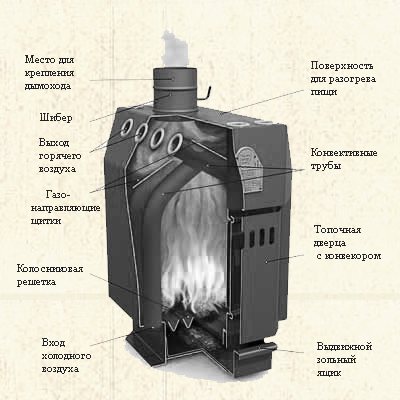

Design
The unit itself consists of several simple elements, namely:
- two-chamber fuel compartment;
- ash pan;
- grate separating the ash pan and the firebox;
- pipes for air movement;
- smoke exhaust installation.
The pipes in Butakov's stoves are installed from above. This is a very convenient and effective solution that allows the condensate to drain directly into the furnace. As a result, the condensate completely burns out, which only increases the performance of the unit. However, such an arrangement of the nozzle causes certain inconveniences when cleaning the chimney.
It is recommended to install Butakov's stove on a small stand.If necessary, such a stand can be easily removed from under the body of the unit, which allows you to conveniently disconnect the stove from the chimney and perform high-quality cleaning.
The firebox of Butakov's stove has a shape close to a truncated parallelepiped. This solution made it possible to ensure efficient and complete use of thermal energy.
The firebox pipes are installed strictly in a vertical position. The only intersection of the pipes is at the top and at a pre-calculated angle.
There are horizontal cuts at the inlet openings of the air duct pipes. In the standard design, these cuts are placed 12 cm from the bottom of the footrests. This solution makes it possible to ensure a completely free flow of air to the gas generator. Gas guide flaps ensure the most efficient use of the gas-flame flow resource.
The door of the furnace compartment of Butakov's furnace is equipped with a convector casing, which allows the door to take part in heat exchange processes.
The design of the unit involves the installation of an ash pan. This is a small box for collecting waste generated during the operation of the stove. The presence of such a box allows you to get rid of ash without interrupting the operation of the stove.
During operation, the upper surface of the boiler in question is in direct contact with the flame stream. This provides an additional benefit. The structure is placed in a horizontal position, which allows you to cook food on it.
Provided that it is assembled correctly, the Professor Butakov furnace operates in the mode of maximum uniform combustion. If it is necessary to ensure a faster heating of the room or an increase in temperature, it is enough to simply replace the standard grate with a replaceable product of an increased size.
Condensate settles on the walls of the chimneys of most existing metal boilers during operation. In this case, the condensate is a liquid waste with a characteristic unpleasant odor. In Butakov's stove, as noted, the chimney connection pipe is installed in a vertical position. Such a constructive solution allows the condensate to be returned back to the stove body. In the oven, the condensate is completely burned out, which slightly increases the heating efficiency.
On average, a gas-generating furnace works for 7-12 hours on one tab of fuel. The operating time depends on the specific oven model.
In order to increase operational safety, the stove can be fixed to the floor.
Fuel
To make the advantages of the stoves of the "Professor Butakov" series more understandable, a simple comparative characteristic of the unit in question with other existing heating installations can be given. For example, Butakov's stove will consume about 2 times less fuel compared to a brick stove of the same size. When compared with a potbelly stove, the fuel consumption in Butakov's stove is reduced by almost 12 times, which is a very impressive indicator.
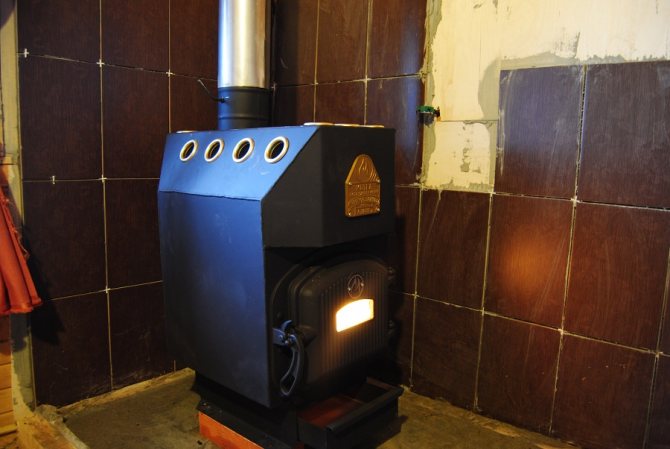

Butakov's stove
It is noteworthy that the gas-generating furnace in question is designed precisely on the basis of the same potbelly stove, which is widespread among summer residents, garage owners, etc.
Various solid fuels are suitable for the operation of the furnace. Most often, pressed paper, coal, firewood, peat, thick cardboard are used.
Application area
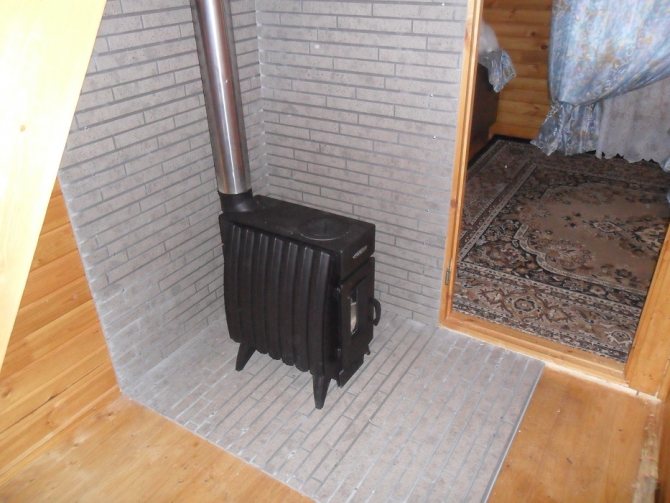

Oven in the house
The considered gas generating furnaces are most popular where it is irrational or impossible to use full-fledged gas or electric heating, i.e. in summer cottages, villages, garage cooperatives, etc.
Such ovens perform well in a variety of cellars, warehouses, garages, basements, hangars, etc.
Operating principle
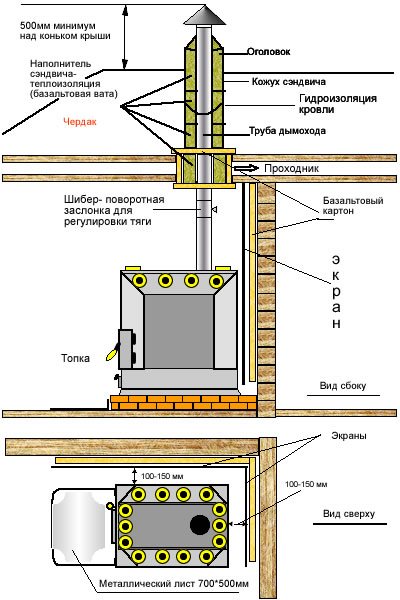

Furnace Professor Butakov
The work of the stove in question is organized according to a fairly simple principle.During operation, air enters the body of the unit through special openings. In the stove body, the incoming air is heated, and then it is discharged into the serviced room.
The fuel in the unit smolders slowly, i.e. a typical pyrolysis process takes place. Under conditions of oxygen deficiency, thermal decomposition of the fuel into charcoal and gases is observed, i.e. fuel is consumed as efficiently as possible.
Thus, the kiln developer, in fact, has not invented anything radically new. However, he carefully worked on correcting the shortcomings of the predecessors of the unit in question, almost completely eliminating heat loss and increasing the heat transfer rate of the stove to 80-90%.
Varieties
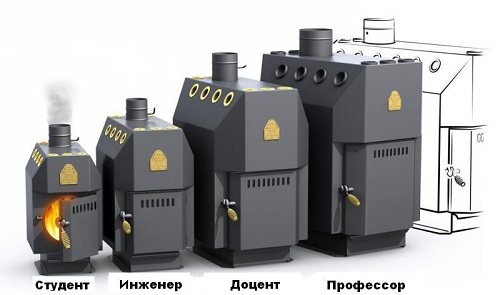

Types of furnace "Professor Butakov"
There are several types of Butakov stoves. Each of the modifications works on the same principle, has a common design and uses the same fuel. The difference lies only in the size of the units, their capacity, the number and diameter of installed pipes. This variety allows you to choose a unit for efficient heating of a specific room with certain dimensions.
The lineup
To date, there are many Butakov oven models on the market. Below we will consider the main ones.
- Device "Gymnaz student" with a power of only 7 kW, it is capable of heating up to 100 m² of area. Chimney height - 5 m.
- Bake "Student" (9 kW) can heat a room up to 150 m². The maximum volume of fuel is up to 20 kg. Chimney height - 5 m.
- Unit "Engineer" Professor Butakov (15 kW) will heat a room with an area of up to 250 m². The maximum volume of fuel is 40 kg. The chimney height is 5 m.
- Bake "Assistant professor" (25 kW) will heat the dwelling up to 500 m². The design holds up to 100 kg of combustible material. Chimney height - 6 m.
- Device "Professor" (40 kW) can heat up to 1000 m² of housing. The maximum volume of fuel is 200 kg. The chimney height is 8 m.
- Unit "Academician" (55 kW) can heat a house up to 1200 m². The furnace can hold up to 240 kg of combustible material.
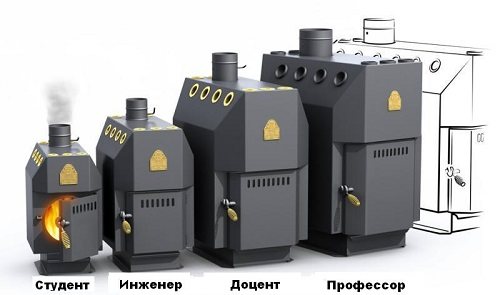

Each model has its own dimensions. The larger the fuel space and the firebox, the larger the dimensions of the stove.
The optimal choice of the device depends on its purpose, the area of the premises requiring heating.
The compact stove "Gymnazist" can heat up to 100 square meters. meters. Its chimney goes up, so this unit is suitable for summer cottages and garage buildings. For other models, the chimney goes up or is located at the back of the structure. They are mainly installed in large rooms.
Characteristics
Considering that Butakov's "Student" oven has various modifications, their dimensions and technical characteristics differ significantly. The common feature of these devices is the presence of built-in convective channels used to increase heat transfer. Depending on the type, the stoves can work both for heating the air and providing water heating.
In this mini-review, we will look at stoves from.
Wood burning stove
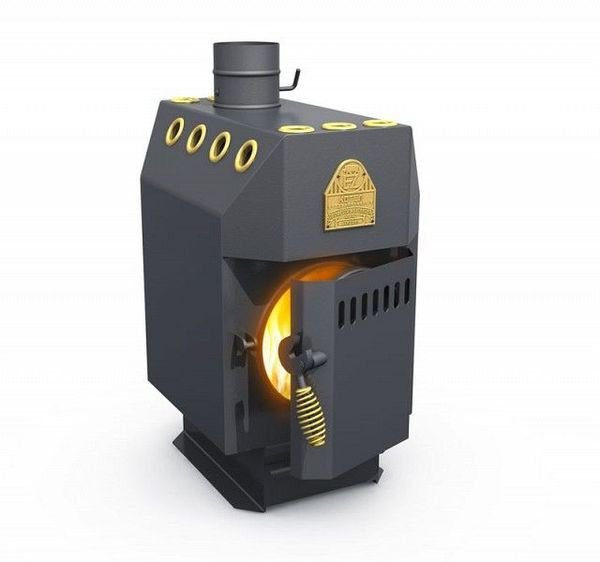

This device is characterized by maximum thermal efficiency and high efficiency in comparison with coal analogues. It has the following features:
- Tightness of the combustion chamber - the door closes reliably, eliminating the formation of cracks.
- Improved control of air supply - the unique design of the gate damper allows you to set the modes of gas generation or just combustion.
- High-quality materials - thick-walled structural steel was used for the manufacture of the case, cast iron - for grates and doors.
In addition, the device is relatively small in size, which are:
- 530 * 780 * 370mm;
- chimney diameter 120 mm;
- the weight of the entire furnace is 77 kg;
- volume of the firebox 74 l;
- power reaches 9 kW;
- The efficiency is 85%.
The stove "Student" has an amazing ability to eliminate soot contamination of work surfaces.Even long-term use will not affect the cleanliness of the glass. The burning time allows you to make bookmarks no more than 1 time in 6-7 hours. The device is equipped with a replaceable grate that allows the air flow to be evenly distributed in the fuel chamber. This eliminates the formation of carbon deposits. The design of the ash drawer allows it to be cleaned without interrupting the combustion process.
Coal stove
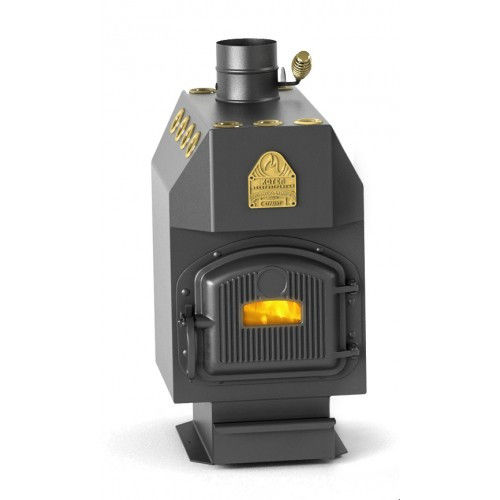

When designing these heating furnaces, the intensity of the thermal load was taken into account. The device has the following characteristics:
- weight - 77 kg;
- furnace volume - 70 l;
- dimensions - 530 * 370 * 780 mm;
- Efficiency - 85%;
- Power - 9 kW.
Burning coal requires more oxygen than wood, but it generates significantly more heat. Due to the 5 mm wall thickness, metal deformation is excluded, which can provoke a quick breakdown of the furnace. The tightness and thoughtfulness of the design can significantly reduce the consumption of coal. A similar stove by Professor Butakov "Student", operating on coal, is an ideal option for systematic heating.
Hydraulics
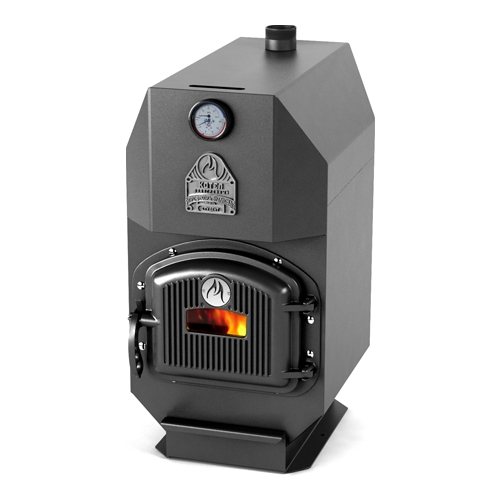

Due to the unique design of the heat exchanger, the long-burning Student hot-water stove has a fairly high heat transfer. The usual coils in it were replaced by convective channels, partially recessed into the firebox. Thanks to these features, the liquid heats up intensively and enters the heating system. This large-sized device has the following characteristics:
- weight - 90 kg;
- power - 16 kW;
- firebox - 70 l;
- dimensions - 720 * 370 * 770 mm;
- The efficiency is 85%.
In addition, the design provides for the installation of heating elements, which allows you to maintain the temperature of the coolant for a long time.
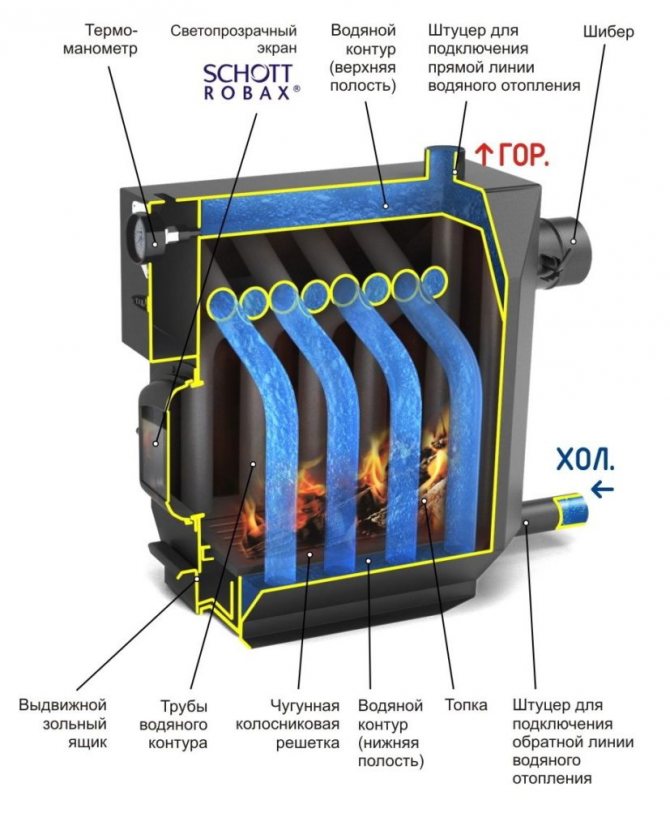

Features of the device of the furnace "Student" Gidravlik
Attention! Electric heaters can be installed independently or purchased together with the boiler
Self-production
Before proceeding with the construction of the device with your own hands, you need to study its diagram:
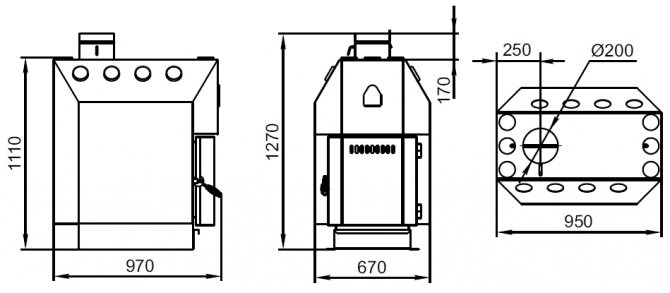

The assembly sequence of this unit is no different from the installation of gas generating furnaces. The basis of the device is a metal barrel.
To obtain a quality unit with safe, economical and efficient heating, follow the instructions below:
- Using a grinder, you need to cut off the top of the barrel, align the sharp edges with a hammer and bend them down.

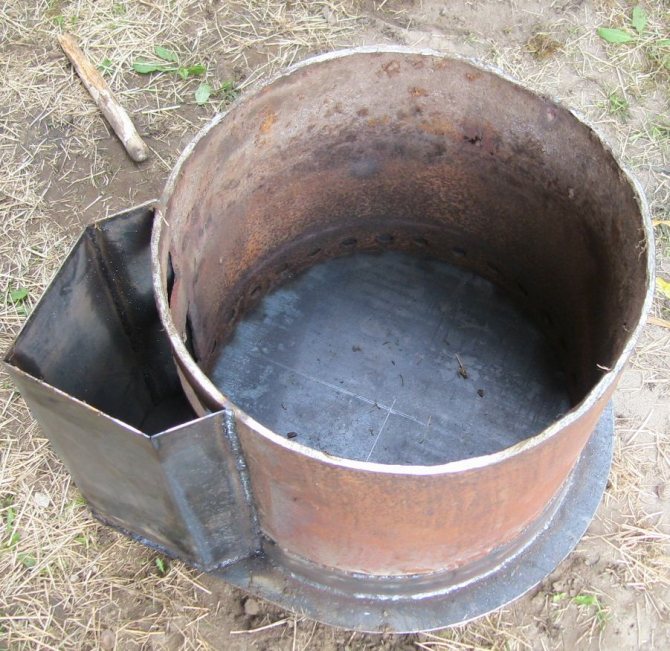
- It is necessary to cut a circle with a diameter of 1.5-2 cm in the steel sheet. This is much smaller than the corresponding size of the barrel itself.

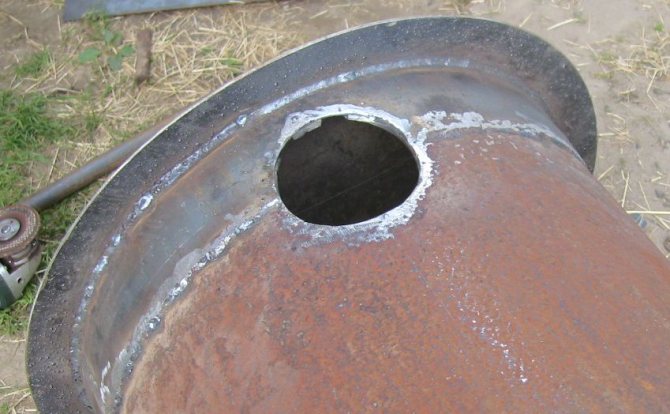
- In the cut out element, you need to make a hole with a diameter of 10 cm and weld a steel pipe of the same size to it.

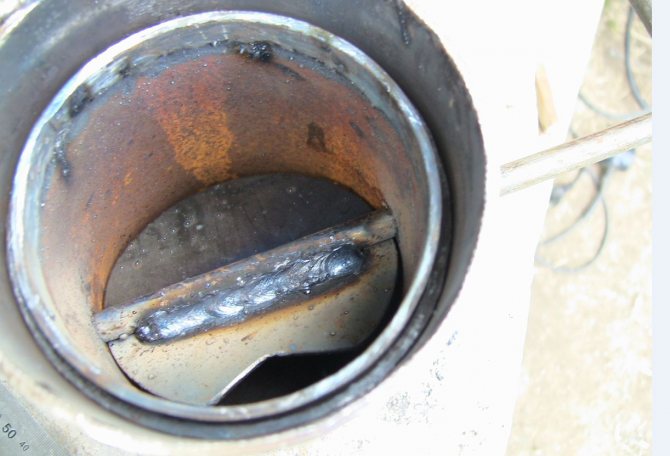
- You will need to attach channel sections to the bottom of the product using a welding machine and install them so that they can move freely inside the barrel. During the operation of the unit, the metal beams will press on the fuel.

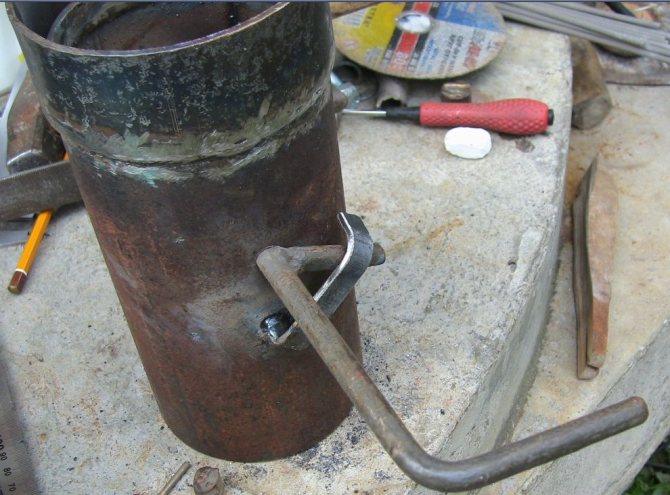
- A damper is mounted on top of the pipe, and the stud is installed strictly vertically.
- This element must be fixed by welding. A hole must be drilled at the edge of a cut-out steel gate valve with a diameter similar to the corresponding pipe size. After installation, the stud must cover the product.

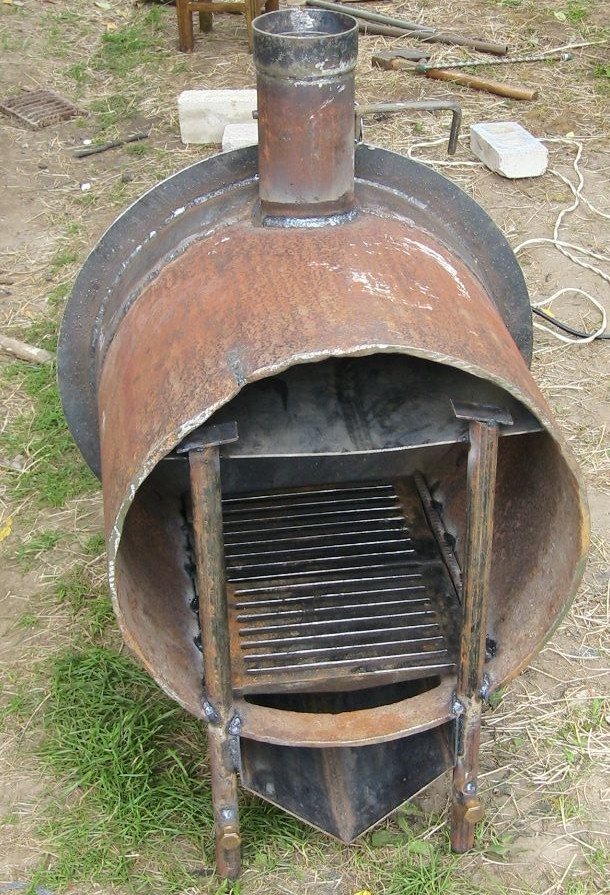
- The damper is screwed in with a nut. The installation of this element allows you to further monitor the volume of incoming air, as well as the intensity of the device.

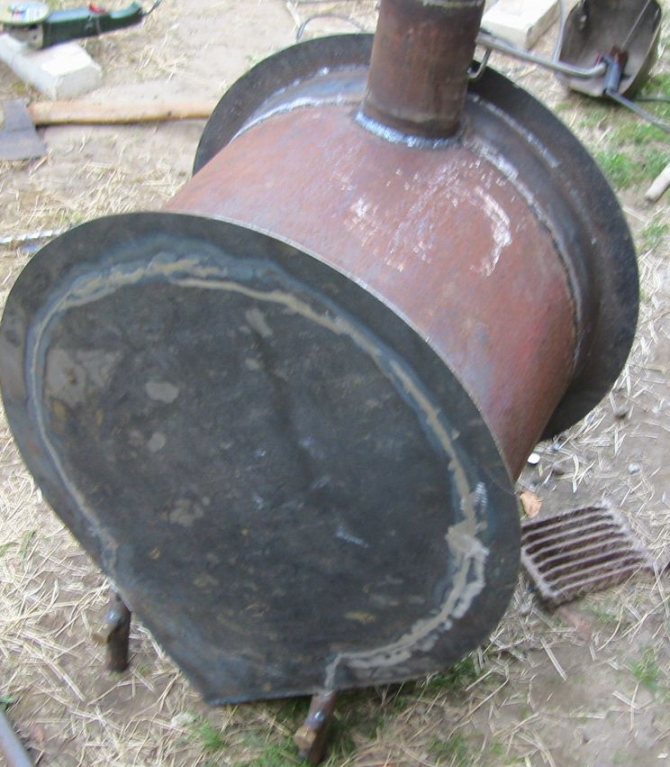
- The flange of the lid must be leveled with a hammer. The edges must be folded outward for a snug fit and adherence to the base.
- In the lid you need to make a hole with a diameter of 10.5 cm. To do this, you need to stock up on a chisel.
- The pipe must be welded to the pancake and brought out through the hole made in the lid, which must be welded later.

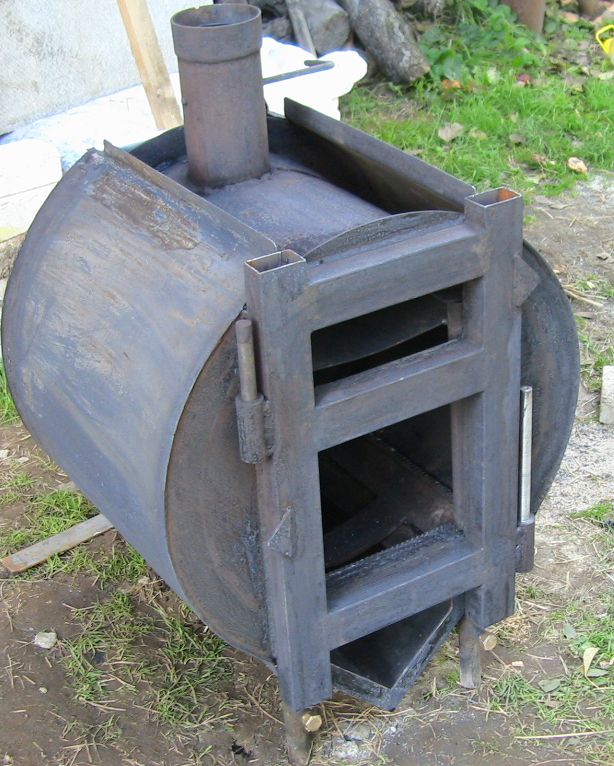
- For the base of the furnace, you can prepare a not too deep brick platform.
- A hole with a diameter of 15 cm is required to be cut in the upper part of the device body.A smoke channel will pass through it, which is 1.5 times longer than the body itself. On top of the structure, a previously measured pipe segment is welded to the hole.
- At the bottom of the device, you need to make a small square hole, then weld the door to it. This will be an ash pan - a hatch for collecting ash, where the box is installed for convenience and ease of cleaning.
- The lower part of the chimney pipe is carefully welded. It is desirable that the product stand on its legs.
- A knee is welded to the channel, the oven is connected. The structure is fixed with a clamp. A fiberglass base is preliminarily placed under this device for the tightness of all joints.

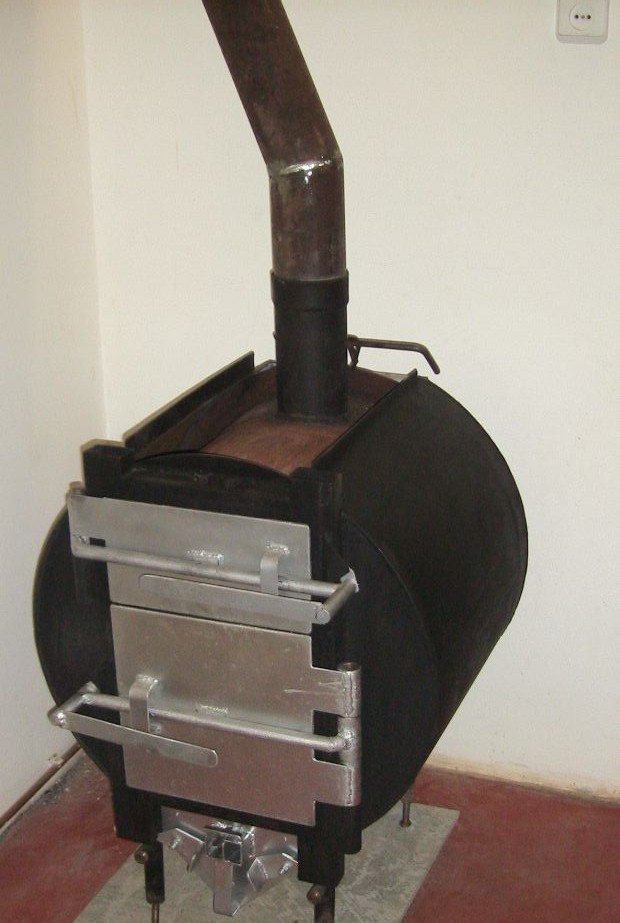
Disadvantages of heating installations Professor Butakov
Like other heat generators, heating installations of the Butakov brand have certain disadvantages:
- Cooking on Butakov ovens takes longer than on conventional heating and cooking heat generators.
- Many users note the difficulty of cleaning chimneys and the stoves themselves after using raw wood or garbage as fuel. However, if you follow the instructions and burn the stove every three days (use the open combustion mode), then this problem can be avoided.
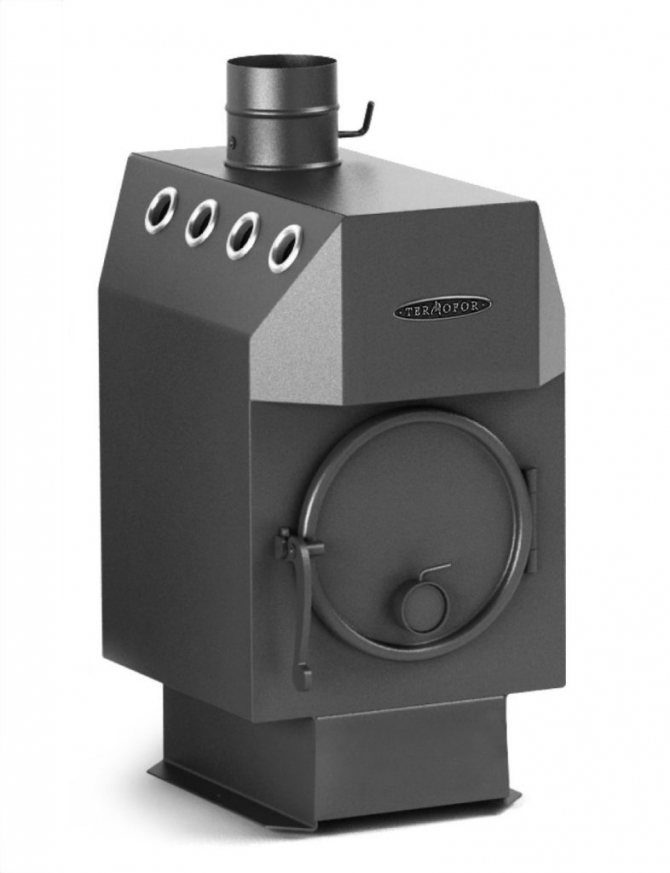

When purchasing heat generators of the Butakov brand, it is necessary to clarify on what energy carrier they can work. Not all models can use peat and coal as fuel resources. Installations Professor Butakov of the "Student" and "Engineer" series, according to their owners, perfectly cope with the heating of small country houses. Moreover, twigs, branches and other waste, which are present in sufficient quantities at the dacha, can be used as fuel for them.
https://youtube.com/watch?v=NHj9sJBlhQU
Furnace installation
The unit can be positioned in the center of the room or built into the wall, simulating a fireplace. In this case, two adjacent rooms will be heated at once.
When installing the oven, the main condition is an unobstructed flow of air. The material must be fireproof, and it is better to use a concrete screed for the base. The chimney heats up quickly during operation and start-up of the furnace, therefore it is important to lay a thermal insulation layer between it and the roof.
In the country, you can heat with scraps of firewood, but the best fuel for such a design is high-efficiency pellets. The principle of operation of the stove is as follows: smoldering is slow, so the moisture content of the wood does not really matter. Dry wood will burn in the same way.
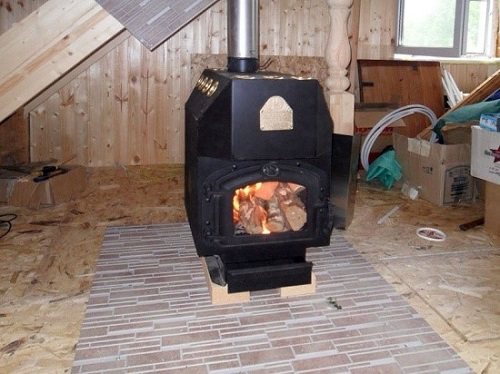

The combustion chamber must be extremely tight. Carbon monoxide does not enter the room, so the stove can be placed next to the sleeping place. One bookmark should be enough for 18-20 hours. The Butakov unit will be the optimal solution when installed in a country cottage with a decent area, or in a country house.
More powerful furnaces are being produced today. For example, a new model “Akademik” with a capacity of 55 kW has appeared. This is a real record among heating appliances of this type. Thanks to its modern design, installation is possible anywhere. A wide range of models meets the needs of everyone.
If you follow all the above recommendations, you will be able to make an excellent device with a long-term burning system at no special cost.
Tips for operating the Butakov furnace
Before starting Butakov's furnace into permanent operation, thoroughly test the unit and determine the most optimal operating mode. During the heating process, the furnace body will heat up to a rather high temperature, so the device must be installed at a distance of at least 30-40 cm from any flammable and melting objects.
The boiler starts up as follows:
- you remove the top cover;
- take out a "pancake" with an air supply pipe welded to it;
- load wood or other suitable solid fuel. Make sure that the load does not cover the flue elbow.Place the firewood vertically and as tightly as possible to each other;
- put small branches on the firewood, and on top of the branches - paper or a rag previously moistened with kerosene;
- put back the "pancake" with the air supply tube and the top cover;
- throw a lighted rag or paper into the opening of the air inlet pipe. You will not be able to light up such a stove with matches - they will simply go out, not having time to reach their destination;
- wait until the firewood burns up, and completely block the shutter of the air supply pipe.
This completes the ignition of the furnace. Check the operation of the unit periodically.
In the absence of a barrel, the body of a large fire extinguisher or a gas cylinder can be used as a base. The assembly principle of the unit will remain the same.
Follow these recommendations and you will make an excellent long burning stove at no extra cost.
Happy work!

